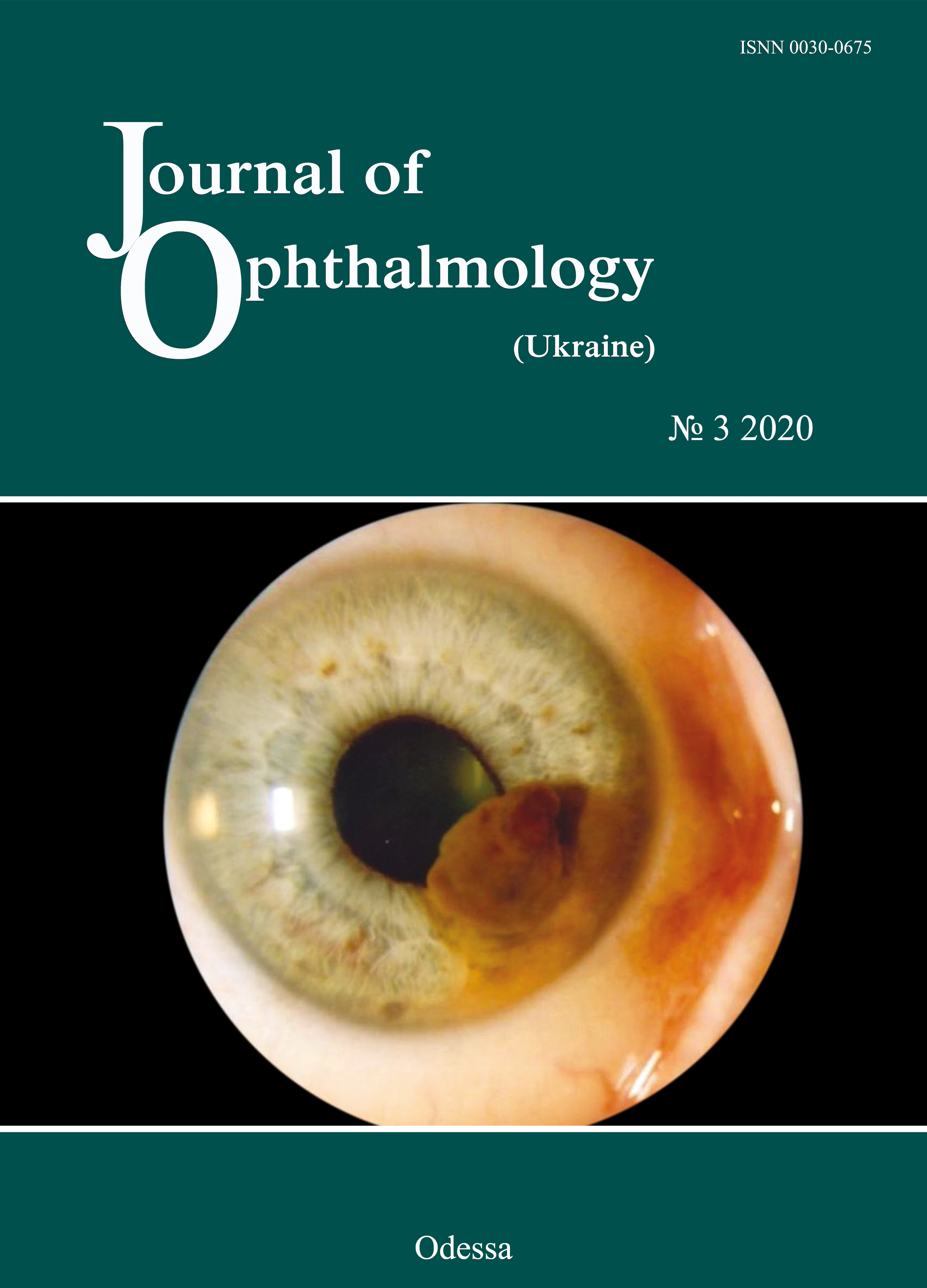Результати прискореного крослінкінгу колагену рогівки при прогресуючому кератоконусі II-III стадії (2-х річний аналіз)
DOI:
https://doi.org/10.31288/oftalmolzh202031622Ключові слова:
кератоконус, рогівка, крослінкінгАнотація
Вступ. В останні десятиріччя для лікування кератоконуса 2-3 стадії застосовують крослінкінг, або перехресне зшивання колагену рогівки (UltraViolet–Crosslinking – UV-X), оснований на процесах фотополімеризації колагену рогівки. В даний час за допомогою приладу останнього покоління (UV-X ™ 2000 фірми Avedro) можливе проведення прискореного крослінкінга, що дозволяє в три рази скоротити час процедури (до 10 хв.) у порівнянні з стандартним протоколом.
Метою нашого дослідження було - оцінити віддаленні результати (24 міс) прискореного крослінкінгу колагену рогівки при прогресуючому кератоконусі II-III стадій.
Матеріал та методи. Крослінкінг колагену рогівки виконано 119 пацієнтам (167 очей). Через 24 місяця після операції офтальмологічні зміни оцінювали на 40 очах. Процедуру крослінкінгу виконували протягом 10 хв. за допомогою приладу UV-X ™ 2000, що володіє потужністю випромінювання 9 mW/см².
Результати. Ступінь астигматизму через 24 міс. зменшилась на 1,15 дптр (n=40) та склала (3,02±1,73 SD) дптр. Заломлююча сила рогівки (за критерієм Kmax) в термін спостереження до 24 міс. достовірно знизилася на 3,4 дптр (54,4± 6,62 SD, mediana 54,3). Через 24 міс після операції зареєстровано достовірне збільшення товщини рогівки за критерієм (thinnest local) на 3,0 мкм до (462,7±34,3 SD) мкм (mediana 455,5 D). При аналізі зміни середніх значень некоригованої гостроти зору (НКГЗ) після акселерованого крослінкінгу через 24міс виявлено підвищення на 0,2 в порівнянні з даними до операції. При аналізі зміни середніх значень коригованної гостроти зору (КГЗ) виявлено підвищення на 0,25 через 24 міс в порівнянні з даним до операції. Всього КГЗ підвищилася на 34 очах (85%) через 24 міс.
Висновки. Процедура прискореного крослінкінгу колагену рогівки на приладі UV-X ™ 2000 дозволяє, крім стабілізації прогресуючого кератоконусу ІІ-ІІІ ст., досягти зменшення ступеня астигматизму на 1,15 дптр, зменшення переломлюючої сили рогівки на 3,4 дптр, збільшенням товщини рогівки на 3,0 мкм, підвищення коригованної гостроти зору в 85% випадків в період до 24 місяців післяопераційного спостереження.
Посилання
1.Bikbov MM, Surkova VK. [Corneal collagen crosslinking for keratoconus]. A review. Ophthalmology in Russia. 2014;11(3):13-8. ttps://doi.org/10.18008/1816-5095-2014-3-13-19. Russian.
2.Birich TA, Chekina AIu, Aksionova NI. [Outcomes of treatment for keratoconus]. Oftalmologiia Belorusi. 2010;1(4):90-7. Russian.
3.Ivanovskaia EV, Vit VV, Golovchenko VG. [Immunological status of patients with various stages of keratoconus and keratoglobus]. Oftalmol Zh. 2000;5:40-4. Russian.
4.Drozhzhyna GI, Troychenko LF, Naumenko VA, et al. [Outcomes of accelerated corneal collagen cross-linking in keratoconus]. Oftalmol Zh. 2018;3:10-7. Russian.
5.Sevastiianov EN, Gorskova EN, Ekgard VF. [Keratoconus (etiology, pathogenesis, medicinal treatment): textbook]. Cheliabinsk: UGMADO;2005. Russian.
6.Solodkova EG, Remesnikov IA. [Modern approaches in the treatment progressive keratectasia]. Prakticheskaia meditsina. 2012;4:75-9. Russian.
7.Croghale NS. Epidemiology of keratoconus. Indian J Ophthalmol. 2013;61(8): 382-3.https://doi.org/10.4103/0301-4738.116054
8.Rabinowitz YS. Keratoconus. Surv Ophthalmol. 1998 Jan-Feb;42(4):297-319.https://doi.org/10.1016/S0039-6257(97)00119-7
9.Georgiou T, Funnell CL, Cassels-Brown A, O'Conor R. Influence of ethnic origin on the incidence of keratoconus and associated atopic disease in Asians and white patients. Eye (Lond). 2004 Apr;18(4):379-83.https://doi.org/10.1038/sj.eye.6700652
10.Li X, Rabinowitz YS, Rasheed K, Yang H. Longitudinal study of the normal eyes in unilateral keratoconus. Ophthalmology. 2004;111:440-6.https://doi.org/10.1016/j.ophtha.2003.06.020
11.Gordon-Shaag A, Millodot M, Shneor E, Liu Y. Gordon-Shaag A, et al. The genetic and environmental factors for keratoconus. Biomed Res Int. 2015;2015:795738.https://doi.org/10.1155/2015/795738
12.Zadnik K, Barr JT, Edrington TB, et al. Baseline findings in the Collaborative Longitudinal Evaluation of Keratoconus (CLEK) Study. Invest Ophthalmol Vis Sci. 1998;39:2537-46.
13.Adel Alhayek, Pei-Rong Lu. Corneal collagen crosslinking in keratoconus and other eye disease. Int J Ophthalmol. 2015; 8(2): 407-18.doi: 10.3980/j.issn.2222-3959.2015.02.35.
14.Kohlhaas M, Spoerl E, Schilde T, et al. Biomechanical evidence of the distribution of cross-links in corneas treated with riboflavin and ultraviolet A light. J Cataract Refract Surg. 2006 Feb;32(2):279-83.https://doi.org/10.1016/j.jcrs.2005.12.092
15.Nowak DM, Gajecka M. The genetics of keratoconus. Middle East Afr J Ophthalmol. 2011 Jan;18(1):2-6.https://doi.org/10.4103/0974-9233.75876
16.Spoerl E, Mrochen M, Sliney D, et al. Safety of UVA - riboflavin cross - linking of the cornea. Cornea. 2007 May;26(4):385-9.https://doi.org/10.1097/ICO.0b013e3180334f78
17.Wollensak G, Spoerl E, Seiler T. Stress-strain measurements of human and porcine corneas after riboflavin/ultraviolet-A-induced cross-linking. J Cataract Refract Surg. 2003 Sep;29(9):1780-5.https://doi.org/10.1016/S0886-3350(03)00407-3
18.Kymionis GD, Portaliou DM, Bouzoukis DI, et al. Herpetic keratitis with iritis after corneal crosslinking with riboflavin and ultraviolet A for keratoconus. J Cataract and Refract Surg. 2007 Nov;33(11):1982-4.https://doi.org/10.1016/j.jcrs.2007.06.036
19.Macsai MS, Varley GA, Krachmer JH. Development of keratoconus after contact lens wear. Patient characteristics. Arch Ophthalmol. 1990 Apr;108(4):534-8.https://doi.org/10.1001/archopht.1990.01070060082054
20.Mazzotta C, Balestrazzi A, Traversi C, et al. Treatment of progressive keratoconus by riboflavin-UVA-induced cross-linking of corneal collagen; ultrastructural analysis by Heidelberg Retinal Tomograph II in vivo confocal microscopy in humans. Cornea. 2007 May;26(4):390-7.https://doi.org/10.1097/ICO.0b013e318030df5a
21.Meek KM, Tuft SJ, Huang Y, et al. Changes in collagen orientation and distribution in keratoconus. Invest Ophthalmol Vis Sci. 2005. 2005 Jun;46(6):1948-56.https://doi.org/10.1167/iovs.04-1253
22.McQuaid R, Cummings AB, Mrochen M. The theory and art of corneal cross-linking. Indian J Ophthalmol. 2013 Aug;61(8):416-9.https://doi.org/10.4103/0301-4738.116069
23.Spoerl E, Huhle M, Seiler T. Induction of cross-links in corneal tissue. Exp Eye Res. 1998 Jan;66(1):97-103.https://doi.org/10.1006/exer.1997.0410
24.Spoerl E, Seiler T J. Techniques for stiffening the cornea. Refract Surg. 999 Nov-Dec;15(6):711-3.
25.Sp?rl E, Huhle M, Kasper M, Seiler T. [Increased rigidity of the cornea caused by intrastromal crosslinking]. Ophthalmologe. 1997 Dec;94(12):902-6. German.https://doi.org/10.1007/s003470050219
26.Tsubota K, Mashima Y, Murata H, et al. Corneal epithelium in keratoconus. Cornea. 1995 Jan;14(1):77-83.https://doi.org/10.1097/00003226-199501000-00013
27.Wollensak G, Spoerl E, Seiler T. Riboflavin/ultraviolet-A-induced collagen crosslinking for the treatment of keratoconus. Am J Ophthalmol. - 2003 May;135(5):620-7.https://doi.org/10.1016/S0002-9394(02)02220-1
28.Shajari M, Kolb CM, Agha B, Steinwender G, M?ller M, Herrmann E, et al. Comparison of standard and accelerated corneal cross-linking for the treatment of keratoconus: a meta-analysis. Acta Ophthalmol. 2019 Feb;97(1):e22-e35.https://doi.org/10.1111/aos.13814
29.Sadoughi MM, Einollahi B, Baradaran-Rafii A, et al. Accelerated versus conventional corneal collagen cross-linking in patients with keratoconus: an intrapatient comparative study. Int Ophthalmol. 2018; 38: 67-74.
##submission.downloads##
Опубліковано
Як цитувати
Номер
Розділ
Ліцензія
Авторське право (c) 2025 Л. Ф. Тройченко, Г. І. Дрожжина

Ця робота ліцензується відповідно до Creative Commons Attribution 4.0 International License.
Ця робота ліцензується відповідно до ліцензії Creative Commons Attribution 4.0 International (CC BY). Ця ліцензія дозволяє повторно використовувати, поширювати, переробляти, адаптувати та будувати на основі матеріалу на будь-якому носії або в будь-якому форматі за умови обов'язкового посилання на авторів робіт і первинну публікацію у цьому журналі. Ліцензія дозволяє комерційне використання.
ПОЛОЖЕННЯ ПРО АВТОРСЬКІ ПРАВА
Автори, які подають матеріали до цього журналу, погоджуються з наступними положеннями:
- Автори отримують право на авторство своєї роботи одразу після її публікації та назавжди зберігають це право за собою без жодних обмежень.
- Дата початку дії авторського права на статтю відповідає даті публікації випуску, до якого вона включена.
ПОЛІТИКА ДЕПОНУВАННЯ
- Редакція журналу заохочує розміщення авторами рукопису статті в мережі Інтернет (наприклад, у сховищах установ або на особистих веб-сайтах), оскільки це сприяє виникненню продуктивної наукової дискусії та позитивно позначається на оперативності і динаміці цитування.
- Автори мають право укладати самостійні додаткові угоди щодо неексклюзивного розповсюдження статті у тому вигляді, в якому вона була опублікована цим журналом за умови збереження посилання на первинну публікацію у цьому журналі.
- Дозволяється самоархівування постпринтів (версій рукописів, схвалених до друку в процесі рецензування) під час їх редакційного опрацювання або опублікованих видавцем PDF-версій.
- Самоархівування препринтів (версій рукописів до рецензування) не дозволяється.












